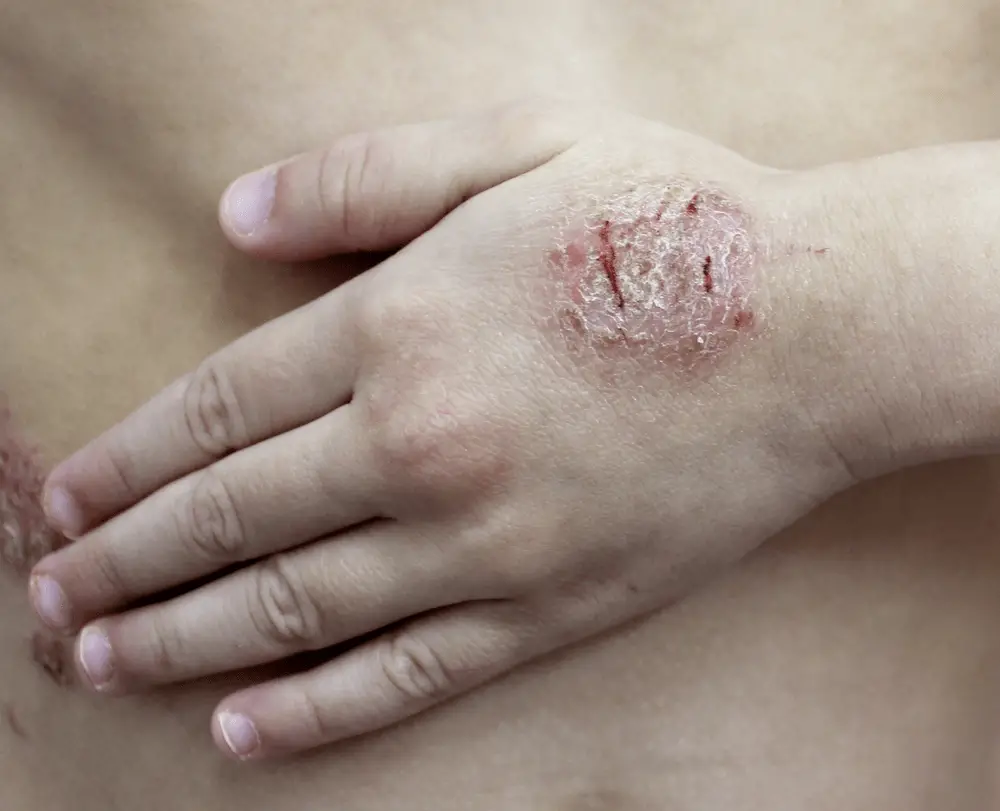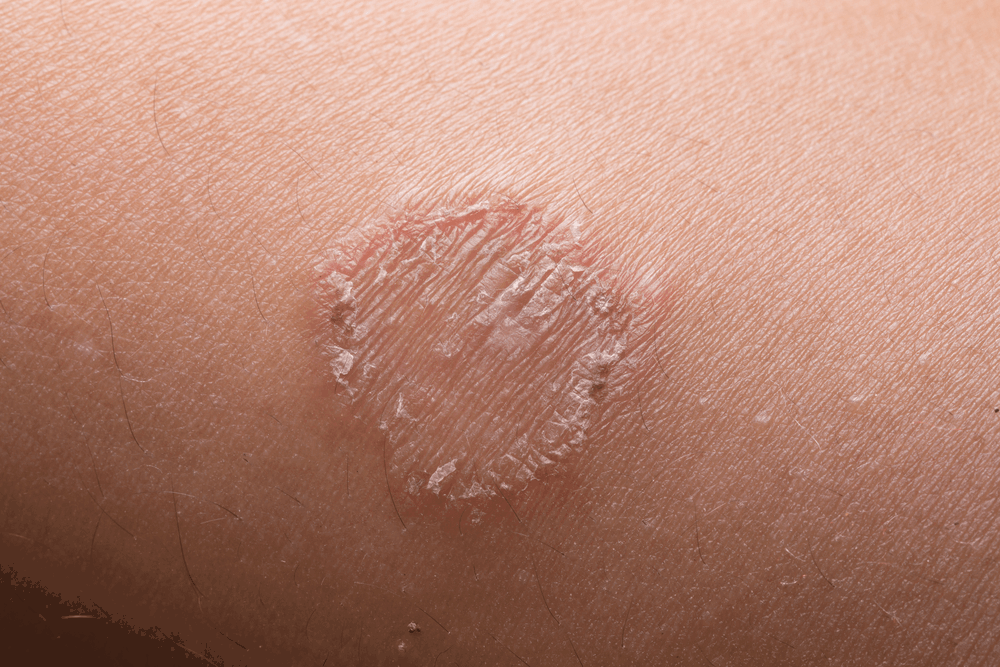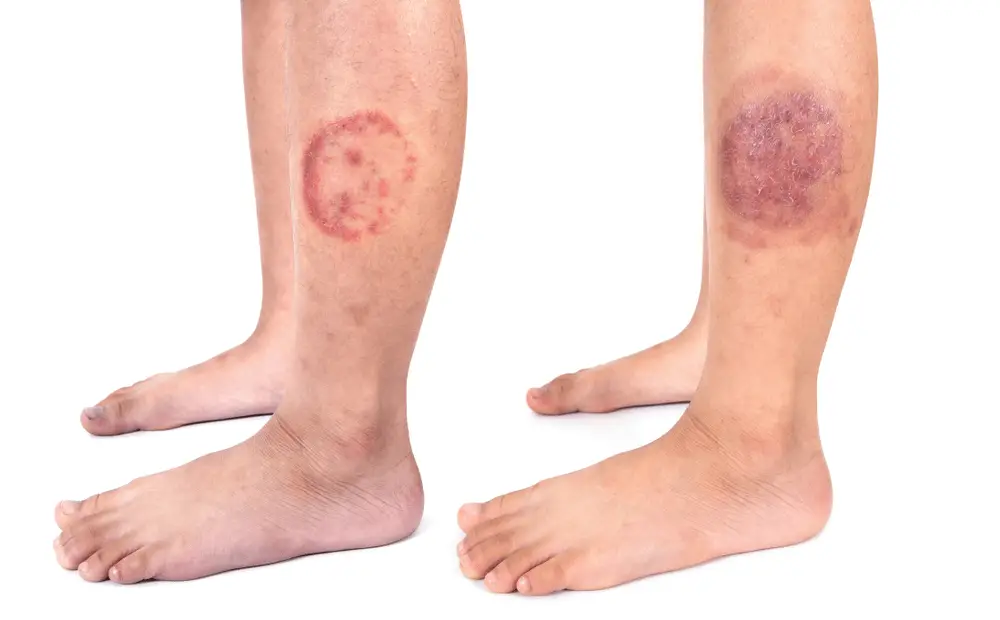If you have developed reddish, circular patches on your skin and are experiencing symptoms like itching and burning, you might be wondering whether you have nummular eczema or ringworm.
These two skin conditions can produce similar symptoms, making it a challenge to tell them apart.
In this article, I’ll discuss the difference between nummular eczema and ringworm in detail. This will provide you with some context in identifying and treating your own condition.
What is Nummular Eczema?
Nummular eczema is also known as nummular dermatitis. The word “nummular” describes the appearance of the condition. The word is derived from the Latin which translates to “coin.”

Indeed, nummular eczema presents as a series of coin-shaped lesions on the skin. According to the American Osteopathic College of Dermatology (AOCD), “The lesions as they get older may clear in the center or become scaly and then resemble fungus (ringworm) or psoriasis. The condition tends to be chronic, with periods when it gets much better or worse.”
What Causes Nummular Eczema?
In terms of its origin, nummular eczema is something of a mystery to dermatologists. The National Eczema Association indicates that it does not appear to be passed down.
There is some research which suggests that contact allergies may be involved in this type of eczema. It is common for the two to occur together.
Even though nobody knows at this point why some people get nummular eczema and others do not, experts have identified triggers and risk factors which seem to increase the chances of nummular eczema flares:
- Contact with allergens, especially metals (nickel being a common culprit).
- Any form of irritation to the skin, such as being scratched or being bitten by an insect.
- Skin being dry, especially over a protracted time.
- Blood flow problems in specific areas.
- Use of topical medications.
Symptoms of Nummular Eczema
If you do have nummular eczema, here are some of the symptoms you might present:
- You could develop lesions which look a bit like “coins.” These most commonly manifest on the torso, arms and legs, and hands. They are likely reddish, brownish or pinkish.
- The lesions may become scaly or may develop a crust. Oozing is possible as well. The presentation can be dry or wet. There is a surprising amount of variation from person to person or even from flare to flare.
- Where nummular eczema forms, you may experience itching and/or burning sensations.
It is possible for complications to occur if a bacterial infection sets in at the site of your eczema.
How Do You Treat Nummular Eczema?
What is required to treat your nummular eczema flares depends on how severe they are. The following are some of the most common treatment approaches.
- Applying a moisturizer can be helpful in reducing dryness and irritation. This also creates a barrier over the top of your lesions, which may reduce your chances of further irritation or infection.
- If the inflammation is running rampant, your doctor may write you a prescription for a steroid anti-inflammatory.
- Another option is a corticosteroid topical medication or a cream containing coal-tar.
- Phototherapy may be an effective treatment for this type of eczema.
Interestingly, nummular eczema can be very responsive to treatment. Some people do get flares repeatedly over their lifetimes, but others may not have a nummular eczema flare-up ever again after it has been successfully treated.
If your lesions are not responding effectively to treatment, that may be a sign of a misdiagnosis. The National Eczema Association writes, ” Because nummular eczema (nummular dermatitis) can look like ringworm, it is important to make sure that it is not a fungal infection, especially if it is not responding to treatment. This can usually be done by your health care provider with a skin scraping or a fungal culture.”
What is Ringworm?
Now that we have talked about nummular eczema in-depth, let’s discuss ringworm in detail.
The name “ringworm” is rather misleading. It probably is an attempt at a poetic description of the perimeter of a ringworm rash. Nonetheless, ringworm doesn’t look particularly “wormy,” nor is it caused in any fashion by a worm of any nature.

What actually causes ringworm is the same type of fungus which can cause jock itch or athlete’s foot.
While ringworm commonly shows up on the scalp, it can also appear in the groin area, on your hands or feet, or pretty much anywhere else on your skin. It can even infect your nails. That means it may also be present on the arms, legs or torso where you could get nummular eczema. It is easy to understand why one condition may be mistaken for the other.
What Causes Ringworm?
As already discussed, ringworm is the result of a fungus. But where does this fungus come from, and what makes one person more likely to get ringworm than another?
Ringworm likes moisture. That means that athletes are prone to getting it because of sweating. Those in humid climates may be more susceptible as well. Clothing which is constrictive, irritating the skin and preventing ventilation, can also be a factor.
Additionally, ringworm is abundant in public, shared spaces. These include showers, locker rooms, dormitories, and so forth.
If somebody else in your household gets ringworm, there’s a very good chance that they will pass it on to you. Likewise, if you get ringworm, it is quite likely that you will pass it on to others who live with you. This is especially true if you are sharing items like towels, but it can happen even if you do not.
Symptoms of Ringworm
Ringworm presents with the following symptoms:
- A ringworm rash looks very similar to nummular eczema and is characterized by discolored patches of skin with a “roundish” shape. As with nummular eczema, they may be reddish, pinkish or brownish. Sometimes, they might be grayish. The borders of the patches are slightly darker and may be raised, with a scaly texture.
- Once ringworm appears in one area, there’s a chance that you will start to develop it in other areas.
- The borders of ringworm patches are more persistent than their interiors. As ringworm goes away, you may notice the borders are the last to go.
- Ringworm usually itches a great deal. You might also experience the sensations of burning or stinging.
- The appearance of ringworm can vary significantly from one body part to another. Ringworm that appears on the torso tends to present differently than ringworm that appears on the feet, the scalp, the groin or so forth. Athlete’s foot, for example, just tends to look like patches of flaky, peeling skin. These patches may not be “roundish” at all.
If you would like to see pictures and read detailed descriptions of how ringworm presents on different parts of the body, see this helpful page from the American Academy of Dermatology.
How Do You Treat Ringworm?
Treating ringworm is significantly different than treating nummular eczema.
- If ringworm is present on the feet, it usually is treated using a powder, cream or spray. These are available over the counter.
- If you have jock itch, you also probably will use a similar product. You may find a cool compress helpful as well.
- Should the ringworm be on your scalp, you likely will receive a prescription medication and will be told to use an antifungal shampoo.
- Prescription medication is usually necessary to clear up nail ringworm as well.
- If ringworm occurs anywhere else on your body, you will probably treat it using a cream or ointment. Your doctor may also give you an additional prescription if your infection is particularly severe.
Normally, you need to treat ringworm consistently for at least a couple of weeks to get it to clear up.
Unlike nummular eczema, however, ringworm loves to recur. For some people, it does go away in one or just a few treatments. But for others, it may come back repeatedly over the course of years. This is especially likely if you are an athlete or use shared public spaces as discussed above.
Nummular Eczema vs Ringworm: Key Points
Now that we have discussed both nummular eczema and ringworm in detail, let’s go ahead and review a summary version of what we have learned.
- Both nummular eczema and ringworm are characterized by the presence of similar-looking roundish patches which tend to be darker around the edges and lighter in the middle.
- It is possible to get ringworm or nummular eczema on the skin throughout your body. Nummular eczema is most common on the arms, legs, hands, and torso. Ringworm commonly affects the scalp, feet, and groin, but it may also show up in the same spots where nummular eczema occurs.
- Itching, burning and stinging sensations are possible with both conditions.
- Despite their similar presentation, the causes of these conditions differ. Ringworm is caused by a fungus. The exact cause of nummular eczema is unknown.
- There are different triggers for each condition as well. Ringworm is most likely to be triggered by humidity, sweating, and exposure to shared public spaces. Nummular eczema is commonly triggered by dryness, irritations, and allergies.
- The appropriate treatment for your condition depends on which one you have. If you have ringworm and use eczema treatments, you are unlikely to be successful, and vice versa.
Diagnosing the Difference Between Nummular Eczema and Ringworm
If it is so easy to confuse ringworm and nummular eczema, how can you figure out which one you have?
It is possible that there are hints in your environment and activities which may shed some light.
If, for example, you spend a lot of time at the public pool, there’s a good chance that what you have is ringworm.
On the other hand, if you notice that contact with a recent allergen seems to be associated with your rash, it could be that you have nummular eczema.
It is also worth pointing out that it is entirely possible to have both conditions. Nothing about being afflicted with one will necessarily stop you from getting the other.
If you are unable to figure out the correct diagnosis on your own, your best move is to talk to your healthcare provider.
Your doctor will be able to run specific tests to help you figure out which condition you have.
- To check if you have ringworm, your doctor will run an analysis on a sample scraped from the affected area. Under a microscope, it is possible to check for the fungus.
- Usually, a skilled dermatologist is able to simply look at the skin and make a diagnosis of nummular eczema. If there appears to be an associated infection, a sample may be taken and analyzed. Sometimes, patch testing for allergies is also conducted if that is believed to be a factor.
Conclusion
You now are familiar with the similarities and differences between nummular eczema and ringworm.
Because of their similar presentation and symptoms, it can be extremely difficult to tell these two conditions apart on your own. Thankfully, both of them can usually be treated within a short timeframe. Hopefully, you will soon identify which you might have. With due diligence, your rash may soon clear up. Remember, if you are unsuccessful in treating your lesions on your own, you should seek a professional diagnosis and further treatment options from your healthcare provider.
One thought on “Difference Between Nummular Eczema and Ringworm: Nummular Eczema vs Ringworm”
Leave a Reply
Recent Posts
Eczema vs Bed Bug Bites: How to Tell the Difference? (W/ Pictures)
Trying to figure out the difference between eczema vs. bed bug bites? If your skin is covered in itchy red welts or splotches, your first thought might be that you are dealing with eczema. It is,...
Best Sunscreen for Babies With Eczema: Top 13 Picks (Updated 2020)
With summer always on the verge, it’s never too early to start looking for the best sunscreen for babies with eczema. Oh yes, even though winter is on the rise at the time of this article...


thank you! this answered so many questions for me, and although I will still see a dermatologist it points me in the direction for some immediate remedy.